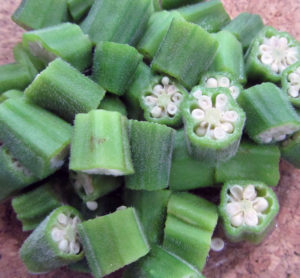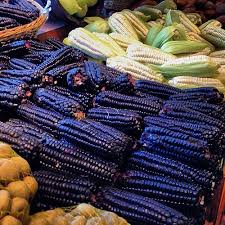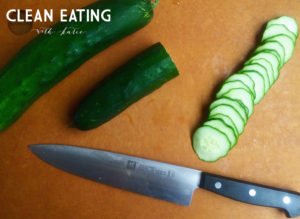Jennifer Tyler Lee has found something that I almost never eat; I believe I have had it once or twice. I don’t think okra is very common out here in California but I know I have seen it in some Indian dishes. It’s not that I don;t like it, but since it isn’t very common I haven’t sought it out much. Jennifer Tyler Lee recommends sautéing it with garlic or making an Okra Risotto. I love risotto, so I’m supporting this option!
Food Facts:
- It originated in Africa and migrated to the Mediterranean.
- It is a mucilaginous veggie which some folks like and other detest.
- Good source of vitamins A, B6, C, and K, folate, niacin, riboflavin, manganese, calcium, magnesium, copper, and potassium.
- Good source of fiber.
- It contains the antioxidants beta-carotene, lutein, and zeaxanthin.
- Studies have shown that the seeds in okra may help reduce the risk of prostate cancer.
- In mice studies, the antioxidants helped to reverse cognitive deficits that were due to nerve damage.
- Cooking okra does not lessen the nutrient value.
- Younger okra pods are less mucilaginous.
From The 52 New Foods Challenge by Jennifer Tyler Lee and Superfoods
by Tonia Reinhard.


 Corn is native to Central America.
Corn is native to Central America. y PhD program, Enders infuses humor throughout her book and her sister creates simple and enlightening illustrations like this one of how to properly use the toilet to go poop (Ender, 2015, p.19).
y PhD program, Enders infuses humor throughout her book and her sister creates simple and enlightening illustrations like this one of how to properly use the toilet to go poop (Ender, 2015, p.19).
 I highly recommend it for all homo sapiens. 5/5 Strawberries!
I highly recommend it for all homo sapiens. 5/5 Strawberries!
 e, Dr. Perlmutter goes even further to discuss the links between an unhealthy gut and Autism, ADHD, allergies skin issues, elevated blood pressure, anxiety, depression, chronic fatigue, inflammation, and many, many, more.
e, Dr. Perlmutter goes even further to discuss the links between an unhealthy gut and Autism, ADHD, allergies skin issues, elevated blood pressure, anxiety, depression, chronic fatigue, inflammation, and many, many, more. Food Facts:
Food Facts: The other fact that helps me feel justified in not liking raw tomatoes is that unless it’s summer, tomatoes are either grown in greenhouses or internationally, or are grown in Florida (Florida’s “soil” is actually just sand and is
The other fact that helps me feel justified in not liking raw tomatoes is that unless it’s summer, tomatoes are either grown in greenhouses or internationally, or are grown in Florida (Florida’s “soil” is actually just sand and is void of nutrients). So unless they are garden tomatoes or farmer’s market tomatoes, they are often mealy and are picked when green. The book
void of nutrients). So unless they are garden tomatoes or farmer’s market tomatoes, they are often mealy and are picked when green. The book 
 Radish greens are edible and have significantly more vitamin C than the roots and more calcium as well.
Radish greens are edible and have significantly more vitamin C than the roots and more calcium as well. ing efforts. Roach states “Rarely does medical science come up with a treatment so effective, inexpensive, and free of side effects” (Roach, 2013, p.321). The main side effect is probably the “ick factor”.
ing efforts. Roach states “Rarely does medical science come up with a treatment so effective, inexpensive, and free of side effects” (Roach, 2013, p.321). The main side effect is probably the “ick factor”.  is a healthier alternative to iceberg lettuce. While working for
is a healthier alternative to iceberg lettuce. While working for  Seventy percent of the US pickle crop is made into pickles.
Seventy percent of the US pickle crop is made into pickles.